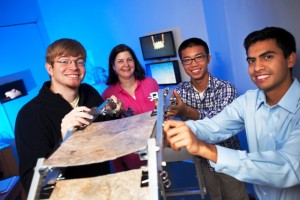How can a building have a fighting chance against a natural disaster?
Anne Raich is seeking ways that active control systems can minimize the structural damage caused by these events. That includes finding more efficient methods of assessing damage post-disaster so that emergency response teams can act quickly to stabilize the structures.

Michael Hezel ’14, l-r, Professor Anne Raich, Jason Sheng ’15, and Eduardo Rodriguez ’14 with the scissor-element truss-arch
“The challenge presented after extreme events is: How can we collect enough good information concerning the structural response so that we can figure out where the structure is damaged?” explains Raich, associate professor of civil and environmental engineering. “This research involves optimizing the number and type of sensors placed on a building to collect the response information and developing data processing techniques that link changes in response to possible damage scenarios.”
It’s this kind of “grand challenge,” she says, that provides rich opportunity for students to test original ideas that could remedy some of the most critical issues facing society today. She involves students in high-level research and design projects to give them the confidence to do this.
For her latest research, Raich is studying computational and physical modeling of origami-inspired deployable structures—reusable ones that can fold into a small size for transportation and install quickly to a much larger space. Examples include emergency housing and movable, temporary roofs for exhibition spaces and sporting events.
Five students have contributed to the project. This past fall, some of their work was part of the Crease, Fold and Bend exhibit at the Williams Center Gallery, and one student presented his work at last year’s National Conference on Undergraduate Research.
The team has developed a computer program that can search for and optimize design alternatives for deployable truss structures. Several virtual and physical models of the structural system have been built to investigate each design’s structural feasibility in greater detail.
Raich has several continuing research projects that have received funding from the National Science Foundation. In collaboration with three other professors, she is working on improving the understanding of the soil-structure interaction behavior of pervious concrete pile systems during installation and under vertical and lateral loads. They have conducted much of their work in the state-of-the-art soil-interaction facility in Acopian Engineering Center.
A student team has helped develop pervious concrete mixtures by testing different aggregate types and measuring the properties of each mix. Students also have helped prepare for pile load tests.
Raich also is leading a student team in the Network for Earthquake Engineering Simulation project to analyze the initiation of cracks in large-scale beam-column connections. They are using computer software to develop models that can aid design engineers in simulating connection behavior more accurately.
“Students who sign on to my projects spend quite a bit of time learning how to use the tools and equipment we use, such as advanced sensors and instrumentation or complex software programs,” says Raich. “Working on research projects helps students gain valuable skills that are essential to be competitive when applying to graduate programs. Being able to say that they have experimental lab experience or that they know how to model using complex software can open up more opportunities.”
